In the summer of 1983 Alan Sugar ordered a computer proyect, the engineers
that made it based in 6502 microprocessor, while the case, keyboard and
cassete was made around separated. This prototype was a dissaster and he
orderer another prototipe to Roland Perry that made the famous prototype
"Arnold" that later will be CPC464. Software was made by Locomotive
that has a soft developed for Z80 and Amstrad acepted that finally this
was the microprocessor of CPC.
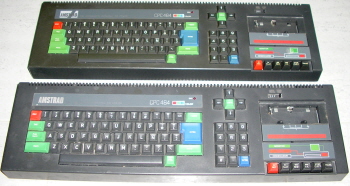
Both apeared in Spain with diferent logos. |
CPC464
Made in UK January 1984 Distribuited in Spain by Indescomp from December of 1984 to 1987 that converts in Amstrad España. CPU Zilog Z80 4 MHz RAM 64 k (42k free) VRAM 16 k ROM 32 k Text Resolution 20 x 25 16 colors, 40 x 25 4 colors 80 x 25 2 colors Graphic resolution 160 pixels x 200 pixels 16 colors 320 pixels x 200 pixels 4 colors, 640 pixels x 200 pixels monocrome Sound 3 chanels, 8 octaves +1 noise channel Printer port Bus expansion Joystick port Disk port Amstrad monitor jack Sound Jack connector In built Cassete OS AMSDOS or CP/M POWER SUPPLY 5v DC (from monitor) |
First Amstrad computer, an historic computer.

Serigraphied version in english. There was another in german. |
Made in Germany with Amstad license 1985 It have the same caracteristics that CPC464 from Amstrad. |
Amstrad version, the colors are changed and the conectors are better quality.

First version without Ñ key 
Second version with Ñ key |
CPC472
Made in Spain by Indescomp for Spain only It have the same caracteristics thah CPC464 from Amstrad, except RAM memory (72K) |
Special version for Spain of CPC464 with 72K . It was made to avoid a spanish law that append a tax to computers of less than 64k that hasn´t spanish keyboard. For Amstrad was cheaper to append a RAM chip than changhe the keyboard and launch a first version without Ñ. Few months later the law was amplied to all microcomputers, the cheat was useless. Then there was two versions one without Ñ and other with Ñ.
|
|
CPC664
Origin in UK From march 1985 to end of 1985 (anounced in August) CPU Zilog Z80 4 MHz RAM 64 k (42k free) VRAM 16 k ROM 32 k Text Resolution 20 x 25 16 colors, 40 x 25 4 colors 80 x 25 2 colors Graphic resolution 160 pixels x 200 pixels 16 colors 320 pixels x 200 pixels 4 colors, 640 pixels x 200 pixels monocrome Sound 3 chanels, 8 octaves +1 noise channel Printer port Bus expansion Joystick port Disk port Amstrad monitor jack Sound Jack connector In built Cassete OS AMSDOS or CP/M POWER SUPPLY 5v DC (from monitor) Disk drive Hitachi 3" |
The proyect was called IDIOT (Insert Disc Instead Of Tape). Oric and Tatung choose this disk format and Amstrad sells disk drives very cheap made by Hitachi.
The computer with 64k RAM and built in disk drive remained a little time in the market and is hard to find. Amstrad replace it quickly by CPC6128, due to RAM memory was cheap and Amstrad wants to introduce in American market and company market and for this they need more RAM memory. Is hard to find due to they made few computers.

This is the version of Amstrad´s Model. |
It have the same caracteristics that CPC664 |
The colors changes respect Amstrad version. Is even more rare than Amstrad computers as only was sold in Germany.
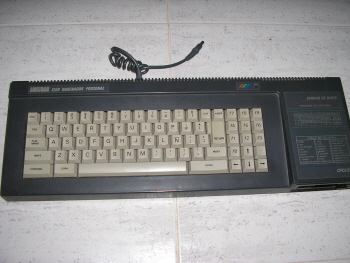
First logo version 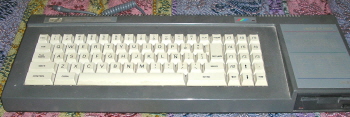
Second logo version |
CPC6128
Origin in UK Summer of 1985 CPU Zilog Z80 4 MHz RAM 128K VRAM 16Kk ROM 32K Text Resolution 20 x 25 16 colors, 40 x 25 4 colors 80 x 25 2 colors Graphic resolution 160 pixels x 200 pixels 16 colors 320 pixels x 200 pixels 4 colors, 640 pixels x 200 pixels monocrome Sound 3 chanels, 8 octaves +1 noise channel Printer port Bus expansion Joystick port Disk port Amstrad monitor jack Sound Jack connector In built Cassete OS AMSDOS or CP/M POWER SUPPLY 5v DC (from monitor) Disk drive Hitachi 3" |
The First Amstrad with 128K and disk drive, later Amstrad put it in Sinclair Spectrum+3 in 1988. Amstrad has a mistake and this format wasn´t any success.
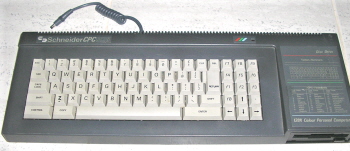
German Versión, there was another in english |
Made in Germany with Amstrad license It have the same caracteristics that CPC6128 |
In this version improved the rear conectors made in the best quality, La ROM is the same according I readed changing 3 jumpers the boot screen turns Amstrad to Schneider (I don´t know which jumpers).
The australian version was imported by Mitsubishi, it was called AWA. Externaly was identical to Amstrad and the only diference was the boot screen (AWA on screen).

Keyboard Spanish versión, the cartidge contains Locomotive Basic and Ocean´s Burnin´Rubber Game |
CPC464+
Origin in UK 1990 CPU Zilog Z80A 4 MHz RAM 64 k ROM 32 k Text resolution 20, 40, 80 columns x 25 lines 16, 4 and monocrome respectively Graphic resolution 160 pixels x 200 pixels 16 colors 320 pixels x 200 pixels 4 colors, 640 pixels x 200 pixels monocrome Sound 3 channel stereo, 8 octaves+1 noise channel Bus expansion Light pen or gun port Stereo sound output (jack) Centronics port 2 Joystick ports (Atari) 1 Analogic port Cartidge Slot RGB monitor DIN output for Amstrad monitor Built in Cassette Power Suppy thought monitor 5V |
It was an attempt to revitalice this antique computers including a console, giving it a look that seems like the new computers that appeared in the market.
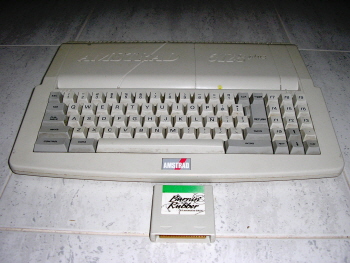
Spanish keyboard version, green color cartidge version |
CPC6128+
Origin in UK 1990 CPU Zilog Z80A 4 MHz RAM 128K ROM 32 K Text resolution 20, 40, 80 columns x 25 lines 16, 4 and monocrome respectively Graphic resolution 160 pixels x 200 pixels 16 colors 320 pixels x 200 pixels 4 colors, 640 pixels x 200 pixels monocrome Sound 3 channel stereo, 8 octaves+1 noise channel Bus expansion Light pen or gun port Stereo sound output (jack) Centronics port 2 Joystick ports (Atari) 1 Analogic port Cartidge Slot RGB monitor DIN output for Amstrad monitor Built in disk drive 3" Power Suppy thought monitor 5V |
Disk version, they sold few in Spain.
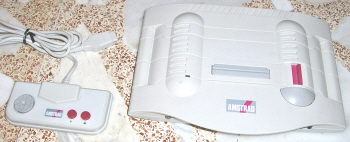 |
GX4000
Origin in UK 1990 CPU Zilog Z80A 4 MHz RAM 64 k ROM 32 k Text resolution 20, 40, 80 columns x 25 lines 16, 4 and monocrome respectively Graphic resolution 160 pixels x 200 pixels 16 colors 320 pixels x 200 pixels 4 colors, 640 pixels x 200 pixels monocrome Sound 3 channel stereo, 8 octaves+1 noise channel Gun port Stereo output jack 2 Joystick ports 1 Analogic port RGB monitor DIN output for Amstrad monitor Scart Euroconector Power suply external 11V or 5V from Amstrad monitor |
Amstrad try to do the same that Commodore with the C64GS to utilice the hardware with incorporated console of plus models plus to launch his 8 bits console, they failed because they was a bad competence with 16 bits consoles due to they has better caracteristics and better price/quality relation.

First Notepad from Amstrad similar to Z88 but more powerful. |
NC 100
Made in UK August 1992 CPU Z80 RAM 64 k ROM 256 k Text resolution 80 columns x 8 lines Graphic resolution 480 pixels x 64 pixels 3 grey tones Sound (beeper) 295 x 210 x 28 mm. / 1 Kg Centronics port RS-232 port Slot PCMCIA Software in ROM: BBC BASIC, word processor, diary, calculator, address book, serial terminal External Power supply 7.5V or 4 bateries AA type 1,5 V |
In 1992 Alan Sugar tried to revitalice the brand computers with this
kind of computers, they was made in Japan.
Amstrad made several PCB motherboards to CPC systems, It called Arnold to all like the prototype made by Roland Perry in 1983.
Arnold 1 for CPC464
Arnold 2 for CPC664
Arnold 3 and 4 for CPC6128
Arnold 5 for CPC464+
Arnold 6 for CPC6128+
Motherboard of GX4000 console (reduced Arnold 5 version)